|
I'm sure I risk attracting the ire of well-read cineastes everywhere by admitting that I was only vaguely aware of the name Baron Munchausen before the arrival of Terry Gilliam's The Adventures of Baron Munchausen in 1988. Only then did I learn that the character's origins lay in a 1785 book by Rudolph Erich Raspe, that the Baron had already made a number of appearances on film, that he was based on a real historical figure (one Hieronymus Karl Friedrich, Freiherr von Münchhausen, if you please), and that he has even had a factitious disorder named after him. I'll also humbly admit also that I wasn't a huge fan of Gilliam's troubled production the first time I saw it (I should note that I really warmed to it on subsequent viewings), which is probably why it was some time before I learned that Gilliam's film and technique was partially inspired by a 1961 take on the Munchausen story made by celebrated Czech filmmaker Karel Zeman.
For too many years, I was largely ignorant of the very real pleasures of 1960s Czech cinema, a deficiency that is being gradually corrected by the output of UK distributor Second Run, the very people responsible for the disc under review here. It was thanks to them that I saw my first and until recently only Karel Zeman film in the shape of the superb 1964 historical black comedy, A Jester's Tale [Bláznova kronika], and it was through this that I was introduced to Zeman's unique visual style, his wild imagination and his glorious sense of fun. Two years before he made A Jester's Tale, these very elements were in full force in what remains to this day the most visually striking and inventive cinematic take on the Baron's adventures, The Fabulous Baron Munchausen [Baron Prásil].
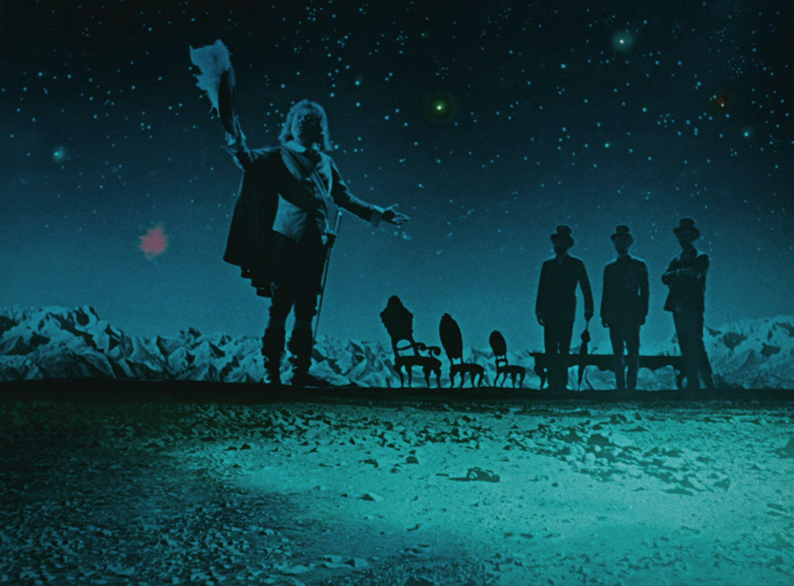
For those who've never encountered the Baron in any of his literary or cinematic incarnations, Zeman's film is likely to make your head spin from its opening minutes onwards. It begins with a series of rapid upward tilts, which move rapidly through the ages from butterflies and birds through the evolution of the aeroplane to a rocket speeding its way to the moon, where the vessel's space-suited occupant – a young astronaut named Tonik – quickly discovers that he is not alone on the surface of our long-believed lifeless satellite. Here he discovers human footprints, a glove, a still-working wind-up gramophone, and a rocket bearing the legend, "Jules Verne, From the Earth to the Moon, 1865," and is greeted by three men who introduce themselves individually as Captain Nicholl, Michel Ardan and Gun Club president Mr. Barbicane. All three are dressed in antique clothing and appear to be doing fine without the aid of spacesuits, and are joined seconds later by Cyrano de Bergerac, who wonders which planet the confused Tonik is from and concludes from his attire that he's a genuine Moonman. The four men invite Tonik to join them for a drink at an ornate dining table, and even before they can take their seats, Baron Munchausen himself rides up on his horse and proposes a toast to their guest, who sits before them in bemusement, his space helmet still firmly in place and his drink untouched before him.
To educate what they believe is their celestial guest, the Baron decides to take Tonik to visit Earth, a journey the two men undertake in a sailing ship carried through space by a team of winged mechanical horses. As they travel, Tonik dispenses with his spacesuit and dons a costume given to him by the Baron that is more in keeping with the year to which they are being transported back. En route they are also passed by two flying witches, one of whose broomstick is supported by balloons. "She's using your science as a backup!" the Baron observes. They land close to the palace of a Sultan to whom Munchausen speaks in a voice that sounds like he has a harmonica stuck in his throat and whose throne has a defence system that activates automatically if approached. Here, Tonik is sent a note by the beautiful Princess Bianca Di Castello Nero, who has been sold to the Sultan and wishes to be set free. Envious of the attention his young companion has attracted from so fair a maiden, Munchausen works with him to plan and affect her rescue, with the ultimate aim of becoming the sole object of her affections.
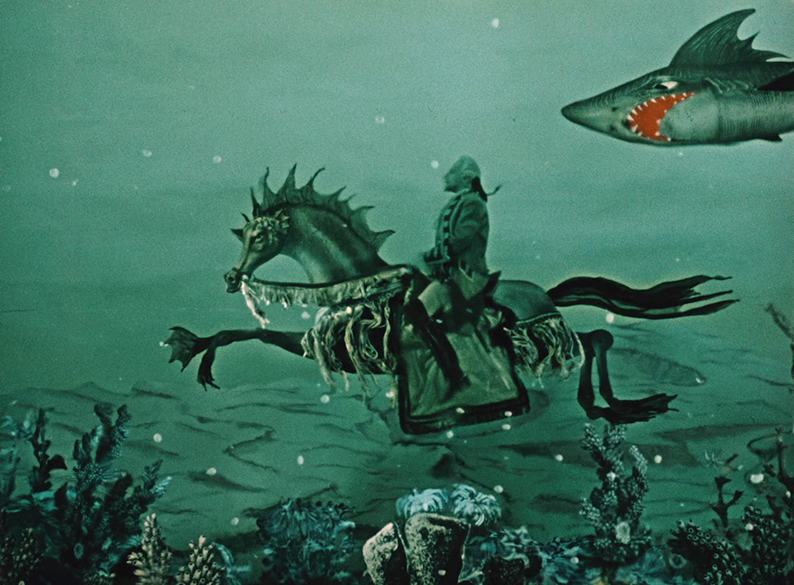
That may seem a lot of plot to outline as an introduction, but by the time the Baron starts talking about kidnapping the Princess we're only 17 minutes into an 85-minute film, and the pace and intensity of imaginative incident never falters. Indeed, this feels less like a story written by a third party than a tale told by the Baron himself to a receptive audience, one full of invention, exaggeration and preposterous boasts, something that the Baron's own matter-of-fact narration confirms is the case. Every sequence is peppered with creatively bizarre and colourful elements, and at times they come at you so thick and fast that you'll need a second or third viewing to assimilate them all. You think I'm exaggerating? Try this for size. Following Tonik's failed attempt to construct a steamship from pre-industrial-revolution components, the Baron is pestered and then snatched up by a giant bird, in whose claw he calmly sits and smokes his pipe until it dawns on him that his departure leaves the Princess at Tonik's mercy. He thus takes off his coat and drops into the sea, and once underwater, collects and rides his horse past all manner of curious undersea coral and flora, while a helpful swordfish gives chase carrying his coat-hangered jacket on its bill, which the Baron then dons to keep out the ocean's chill. He resists the charms of a passing mermaid, which then transforms into a predatory shark that he simply shoos away, then he rides into the mouth of a huge fish and out of a second mouth located on its opposite end. Detecting the nearby presence of the Princess, he then rises to the surface to board the ship on which she and Tonik are now travelling. All of this happens in just four minutes of screen time.
And then there's the detail. The Fabulous Baron Munchausen is a consistently gorgeous-looking film, one whose every shot is a small work of meticulously designed and realised art, and I use that term in its literal sense. Where Gilliam would later employ an ever-expanding budget to build striking sets and employ eye-catching effects, Zeman creates fantastical visuals by combining live action with foreground and background imagery that has the look of period engravings, with which the actors are able to interact and even climb and walk through. A consistency of style is ensured by creating props that also look like hand-crafted illustrations, making them visually indistinguishable from the drawn backgrounds against which they sit and only identifiable as props when they are lifted or moved. It's a unique and bewitching style that Zeman had by this point been employing and perfecting for some years and would also use in A Jester's Tale. The style is particularly suited to the tale being told here, being a fanciful concoction liberally peppered with dream-like components and that looks and feels like a richly illustrated storybook that has been magically brought to life. And while essentially a colour film, it seems likely that the live action material was all shot in monochrome and subjected to creative colour tinting in post-production.
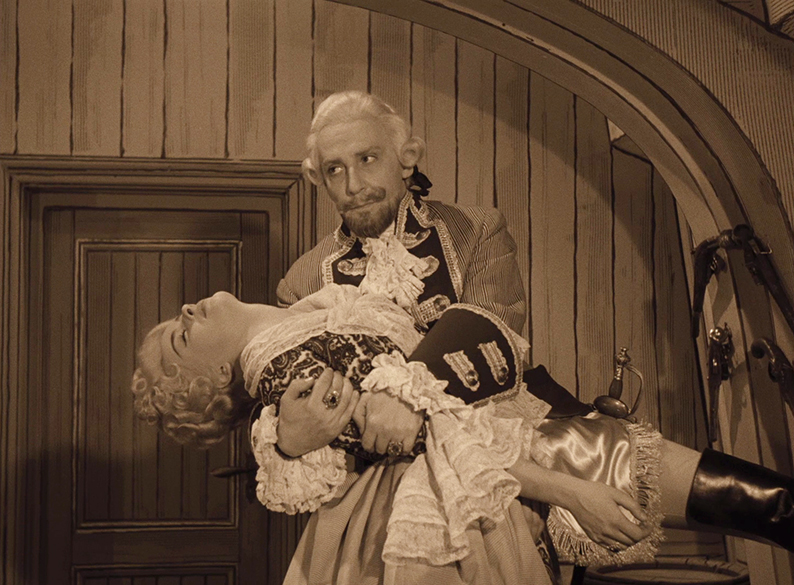
The cast are largely pawns in the director's hand, but Miloš Kopecký still makes for an engagingly nonchalant Munchausen, as unflustered by crisis as he would paint himself to others as being, and treating every encounter with man or beast with the calm of someone who has seen and done everything and for whom life now holds little in the way of surprises. This provides its share of humorous asides, from the absurdist (at one point, the Baron's ship is shrouded in a protective fog created by everyone on board quickly puffing away on pipes, including the figurehead) to the creatively slapstick, as when the Baron's attempt to kick a window closed whilst supporting the swooning Princess sees him jam his boot into the window's lattice. There's even a wonderful, blink-and-you'll-miss-it moment when the boat on which the Baron is travelling (which is currently in the stomach of a giant fish, of course) is being violently rocked and he and the Princess are being thrown backwards and forwards. During the course of their tumbling, the Baron falls back into a chair and just for a single, perfectly judged second, adopts the calmly unflustered pose of a gentleman at leisure, only to then immediately be thrown back on his feet. That said, for sheer, laugh-out-loud gags, an absolute gem involving a castle door that neither Munchausen nor Tonik are able to open takes some beating.
The Fabulous Baron Munchausen (sometimes known, a tad less poetically, in the English-speaking world as The Outrageous Baron Munchausen) is a technical and artistic marvel (the design and detail of Zeman's own lithographic illustrations are jaw-dropping in themselves) that also scores as a delightful entertainment, one whose every shot has clearly been meticulously planned and composed and whose dream-like air is enhanced by The Cremator composer Zdenek Liska's wonderfully diverse score, which flits merrily between a range of genres and styles. Neatly categorising the film is nigh-on impossible – it's a surrealist odyssey, a storybook in motion, a gallery of intricate artwork brought playfully to life and a lively entertainment, and in common with its colourful subject, it's absolutely brimming with invention and imagination.
The result of a 4K restoration, this 1080p HD presentation of the film is a joy to behold. The image is spotless and wonderfully crisp, which further flatters the intricate detail of Zeman's drawn artwork. The contrast is also sublimely pitched, ensuring that the black ink of the etchings never slips into dark grey, remaining solid even under the various coloured tints, which are vibrantly rendered but never feel over-saturated. There's also a richness to the image in general that sings a hymn to the vibrancy of the best high-definition transfers. Terrific.
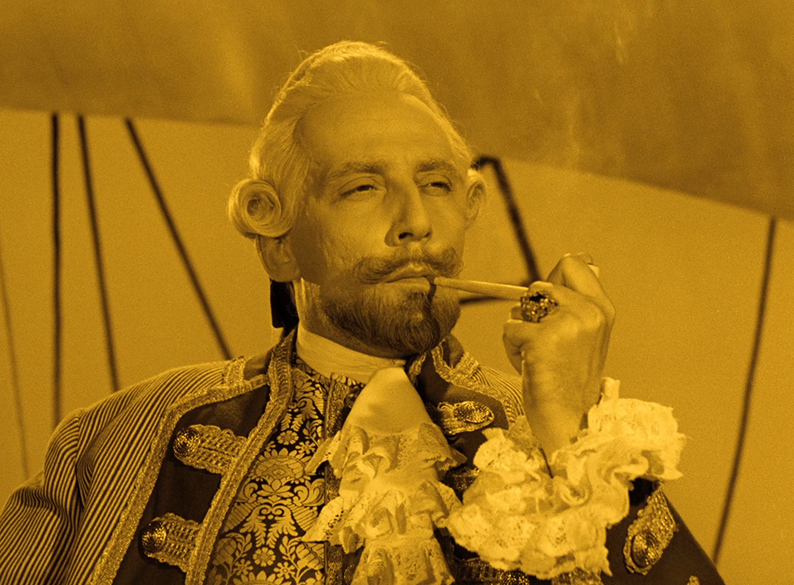
The Linear PCM 2.0 mono track is also in impressive shape. Inevitably, there are some range restrictions on dialogue and some of the sound effects, but both are clearer and brighter than you might expect, and the music and some of the effects – the bang of a gong, a fanfare of trumpets – sound great. There's also no trace of serious damage, and the background hiss I detected on one scene may well have been part of the intended soundtrack.
The clear English subtitles can be switched off if you're a fluent Czech speaker.
Film Adventurer Karel Zeman (101:48)
Oh, that every great filmmaker could have a film about their life and work as detailed, revealing and captivating as this feature-length documentary on Karel Zeman by his filmmaker daughter Ludmilla. Zeman's early life and career are covered in fascinating detail here, as are a number of his key early films, including A Journey to the Beginning of Time (1955), The Fabulous World of Jules Verne (1958) and, of course, The Fabulous Baron Munchausen. We're shown how some of his more ingenious effects were created, and there's even archive footage of Zeman at work, some of which is so well shot that I couldn't help suspect that there's an earlier documentary on him out there somewhere that this material was sourced from. A number of his collaborators and Ludmilla herself are interviewed, as are a selection of his prominent admirers, including filmmakers Terry Gilliam, Tim Burton and Yamamura Kôji, film critics Kamil Fila and Ono Kôsei, director of the Montreal World Film Festival Rock Demmers, Curator of the Ray Harryhausen Foundation Tony Dalton, and Paul Wells, Professor of the Animation Academy at Loughborough University. The many extracts from Zeman's earlier work are a tantalising delight, and running throughout the film is some newly shot and utterly fascinating footage of what has to be one of the best film animation classes in the world, where the students are tasked with recreating a selection of key effects shots from Zeman's films using only the technology that was available to him. I could happily have seen this run for another hour to enable it to spend more time on his later films, but this is still a brilliant companion to the film that will leave you aching to see all of Zeman's other work.
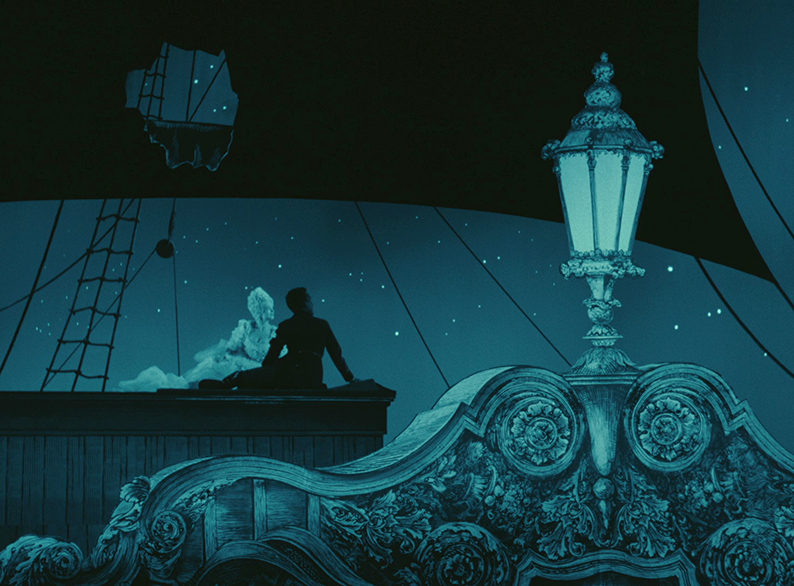
Facts and Fibs: Michael Brooke on Baron Munchausen (36:11)
New to the world of Baron Munchausen? Then this detailed, meticulously researched and illustrated trip through what appears to be his every appearance in literature and film by the learned Michael Brooke is the only introduction you'll need. It's an enthralling and for most of us hugely educational experience, and crams so much information into its 36-minute running time that I have a feeling I'll be returning to it a later as a reference work – there's just too much to absorb in a single sitting. As there are extracts from the main feature that are best enjoyed in context, I'd probably still save this for after the film itself (the same goes for all of the extras here, of course).
The Birth of a Film Legend (5:10)
The first of a small selection of short but pleasingly concise extras on this disc that appear to have been sourced from a previous (Czech?) DVD release, and bear the production logo of Museum Karel Zeman. This one looks at Karel Zeman's early years, his first experiments with puppet animation, and his specific approach to a medium that he was learning through solitary experimentation and study. Includes contributions from his daughter Ludmila Zeman and his friend and collaborator Karel Hutĕčka.
Karel Zeman and the World (5:05)
Essentially a brief collection of clips from the Film Adventurer Karel Zeman documentary of primarily English-speaking contributors (Japanese filmmaker Yamamura Kôji is the exception here) outlining what it is that makes Zeman's films so special. Treat this as a trailer for the documentary itself.
Why Zeman Made the Film (3:46)
In the second of the Museum Karel Zeman shorts, Zeman himself outlines his reasons for making the film, while his daughter reveals that he was determined to make something that differed greatly from the lavish 1943 German production, Münchhausen. Lead actor Miloš Kopecký assures us that the point of the film was to celebrate the human imagination. I'd say it nailed it.
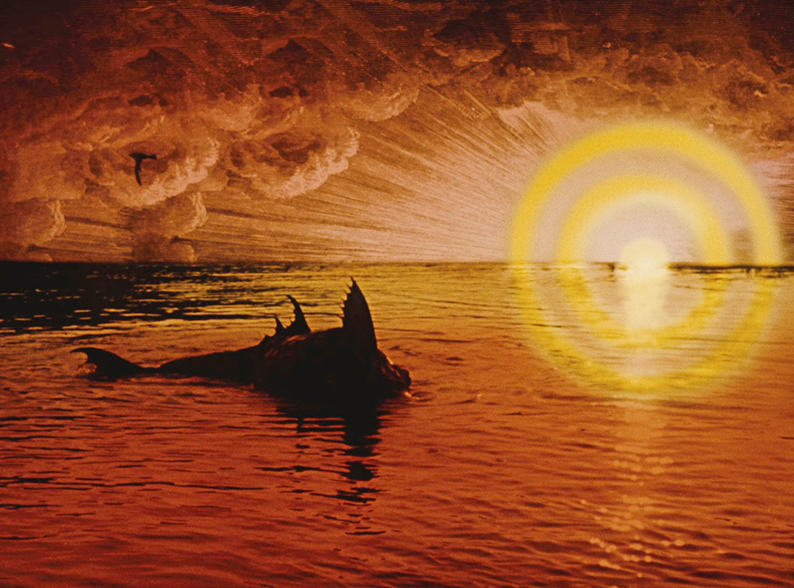
The Cast (2:23)
Another Museum Karel Zeman piece, this one chats briefly with lead player Miloš Kopecký, who describes acting for Zeman as like the first day of creation, while Ludmila Zeman suggests that her father treated his actors like puppets.
Zeman's Special Effects Techniques (1:49)
A brief peek at how two of the special effects sequences used in the film were achieved, both of which are covered in more detail in the main documentary.
Karel Zeman, the Legend Continues (3:30)
Another brief but welcome Museum Karel Zeman short looks at how Zeman's career evolved and how things became more difficult for him later. Karel Hutĕčka tells a story about Zeman's 80th birthday party here that he repeats almost word-for-word in the main documentary – it's clear this made a real impression on him.
Trailer (1:40)
A lively trailer for the digital restoration that does give a flavour of the ride ahead.
Museum Karel Zeman (1:17)
A commercial for the Karel Zeman Museum, which frankly looks wonderful and is being sold on the slogan, "Bring your childhood dreams to life!" I'll be there!
A wonderful melding of art and entertainment that delights as much in its technique as its inventive storytelling and its sense of fun, one that left me aching to get my hands on some of Zeman's earlier works, tantalising glimpses of which are peppered throughout the special features. A terrific film, a superb HD transfer and a sublime collection of extras (including one of the most enthralling filmmaker documentaries I've seen in years) make this one of Second Run's finest releases yet. Highly recommended.
|